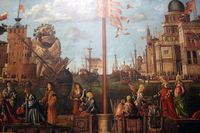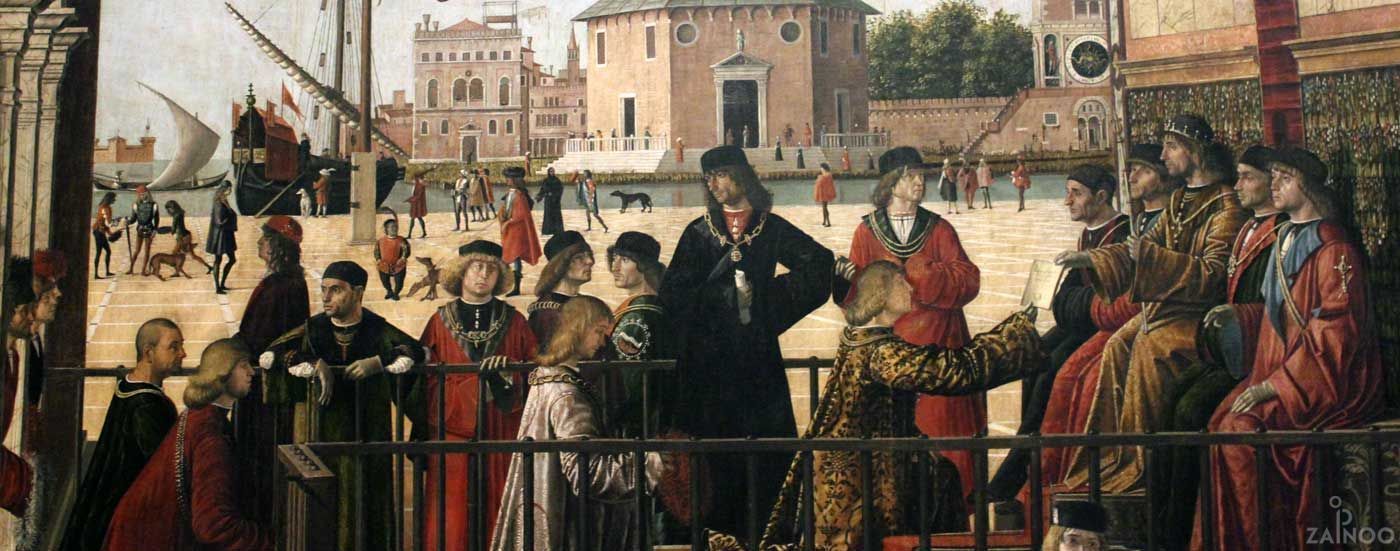History of Venice
Venice’s ascent to the Queen of the Adriatic
During the period of mass migration and the invasion of the Huns, many mainland residents took refuge in the lagoon and built their settlements on the islands. The Venetian fishermen sailed to sea and set up a commercial empire. The Doge republic became the dominant power in the Mediterranean region. At the height of its power the Venetian possessions extended from Cyprus to Dalmatia and Istria to the Alps. Long and bloody battles against the strengthened Ottomans and the shift of the trade centre to the Atlantic Ocean resulted in the gradual decline of the Queen of the Adriatic. In 1797 Venice capitulated without a struggle to the French and was incorporated by Italy after the period of Austrian occupation.
The origins of Venice
It is difficult to trace back the founding of Venice to an exact date. With the fall of the Roman Empire and the invasion of Germanic tribes and Huns from the north, many of the residents of what is now Veneto fled to the protected Venetian lagoon. The first settlements were founded on the islands of Torcello, Murano and Lido (then Malamocco). Under the protection of the Eastern Roman Empire the first Doge was appointed in 697. He first resided in Lido and tried to unite the warring islands. It was only when Pippin, son of Charles the Great, laid siege to the lagoon and destroyed Malamocco that the divided island was united and a new city on the central group of islands at Rivus Altus (Rivo Alto, or present-day Rialto) was founded – the Venice of today was born.
Venice: Rise of the Queen of the Adriatic
In 812 Venice became a Byzantine province – under the protection of the Eastern Roman Empire, the city was able to develop in peace. In 828 Venetian merchants stole the bones of St. Mark the Evangelist from Alexandria, who became Venice’s patron saint. His symbol, the winged lion, was from now on the landmark of Venice. Living on the water, the Venetians were skilled sailors and merchants. Thanks to the protection of Byzantium, which opened all ports to the Venetians, the lagoon city quickly developed into a state trading power and managed to gain extraordinary wealth. Due to the volume of trade, Venice eventually became the largest financial centre in Europe. A powerful navy provided military might, and so, one after the other, Venice conquered Friuli, Istria and Dalmatia. Venice took advantage of the Fourth Crusade to the Holy Land to attack its former patrons and occupy Constantinople. With the conquest of the Byzantine Empire, the Greek Aegean islands also belonged to the Venetian empire. Many art treasures from Constantinople, including the horses on St. Mark’s cathedral, came to Venice. In 1381 it defeated the arch enemy of Genoa at Chioggia and the Doge republic dominated the entire eastern Mediterranean region from then on. With some 150,000 inhabitants, Venice itself had grown to become the third largest city in Europe after Paris and Naples. A European great power – the Queen of the Adriatic – was born.
Destruction of the proud naval power
With 3,900 merchant ships and 15,000 sailors, Venice dominated trade in the Mediterranean region. The state itself enjoyed stability and, with the exception of the unsecured hinterland, no one posed a danger to the sea power. The hinterland was therefore secured in relatively short order, and, one by one, Padua, Vicenza and Verona fell to Venice. When it finally conquered Cyprus, the Venetian empire reached its peak and Venice reached the height of its power. In 1453, however, the tide began to turn with the conquest of Constantinople by the Ottomans. Venice was involved in a 300-year war against the Turks. At the same time, with the discovery of America, the trade centre shifted from the Mediterranean Sea to the Atlantic. In Europe, new powers were formed and Venice slipped increasingly into political isolation. In the League of Cambrai, Austria, France and Spain formed an alliance against Venice. Despite a last major victory at the Battle of Lepanto against the Turks, the Venetian empire began to crumble across the board. After two devastating plague epidemics (1575 and 1630) and further wars against the Ottomans, Venice finally gave up its possessions in the Mediterranean region and focused on defending its territory around the lagoon.
Venice from modern times to the present day
At the end of the 18th century Venice experienced a cultural high but was politically a mere shadow of itself. When Napoleon appeared in front of the lagoon in 1797, the city surrendered without a fight. Napoleon looted the city before giving it to the Austrians, who incorporated Venice into the Habsburg Empire until 1866. The Austrians modernised the lagoon city and connected it to the mainland for the first time with a railway bridge. In 1866 the Habsburgs moved back from Venice and left the lagoon city to the new Italian kingdom. Poverty and economic decline characterised the years that followed. It was only after the First World War that the port was moved to Marghera and the Venetians began the construction of heavy industry. With the onset of tourism in the second half of the 20th century, the recent rise of the lagoon city began, which has continued to the present day. Venice’s future success, however, will depend on solving environmental problems in the lagoon.




Tweet